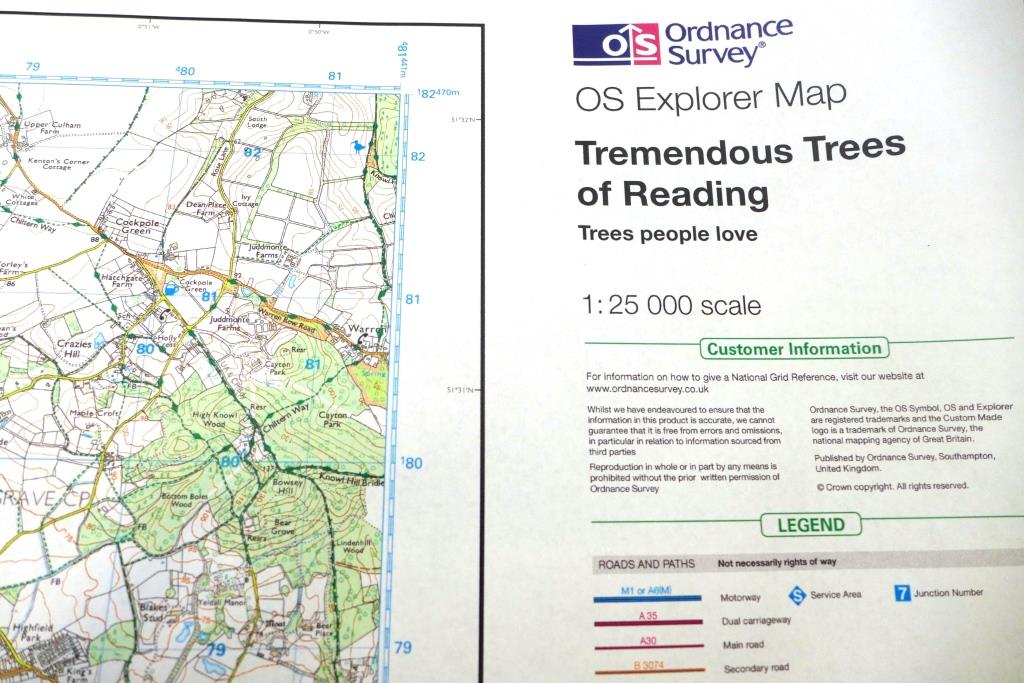Tremendous trees & the science of surveying
Earlier in the year, Project Archivist, Nancy Fulford went on a training event organised by RE:LEAF in London, a partnership campaign led by the Mayor to protect the capital’s trees and encourage individual Londoners, businesses and organisations to plant more trees. Nancy discovered that there are several national and local initiatives to survey trees. Inspired by her findings, Nancy decided to share her new skills with colleagues and visitors to MERL by organising the Tremendous Trees event on Saturday 16th August.
The University of Reading has over 8000 trees across the Whiteknights and London Road campuses, residential sites and here at MERL. The University’s Grounds Team looks after our trees and regularly surveys them to check growth and health, and earmarks trees that may pose a risk to the public, such as those with branches damaged by strong winds or weakened by dying wood.
Across the country trees are being surveyed and the results added to websites such as Treezilla and OPAL (Open Air Laboratories). Treezilla is a citizen science initiative which aims to create a ‘monster map’ of British trees. Anyone can sign up and start inputting data about the trees in their local area. Similarly OPAL is encouraging people to conduct a tree health survey.
Trees provide us with a range of amazing benefits which we cannot obviously see. These benefits, often referred to as ecosystem services, can be calculated and translated into a monetary value using the results of the survey. We are surveying some of the trees in the MERL garden to add to Treezilla’s monster map and see exactly what they are doing for us! The benefits calculated by Treezilla are:
- Greenhouse gas benefits
Carbon dioxide is absorbed by trees and oxygen released, giving environmental and health benefits.
- Air quality benefits
Various pollutants are absorbed by leaves, improving the quality of the air and in turn improving the social environment we live in.
- Energy benefits
Shade from trees helps imrove climate conditions inside buildings so that less energy is required to cool or heat areas of buildings.
- Water benefits
Leaves hold rainwater, limiting the amount of water run-off which can pollute our water systems.
Additional benefits provided by trees include aesthetic value, noise reduction and general wellbeing.
Here’s one of the trees we have surveyed in the MERL garden and the results:

Greenhouse gas benefits: 527.7 kg CO₂ reduced = £12.66 saved
Water benefits: 1,725.3 litres conserved = £2.87 saved
Energy benefits: 1,339.5 kWh conserved = £53.58 saved
Air quality benefits: 2.7kgs = £10.19 saved
Total annual savings = £79.30
If you’d like to learn more about the science of tree surveying and have a go yourself, come along to the free Tremendous Trees event this Saturday between 1 and 5pm. You will be able to book on to free tree surveying workshops at 1.30pm and 3.30pm on arrival. The event is suitable for all the family, with a leaf-rubbing craft activity as well as the opportunity to see a display of objects relating to forestry and tree-related items from the MERL library and archives. You’ll also be able to mark our favourite local trees on our very own map…
For more information, visit the Special events page on the MERL website
One thought on “Tremendous trees & the science of surveying”
Leave a Reply
You must be logged in to post a comment.


Wokingham District Veteran Tree Association has been recording veteran and significant trees across Wokingham Borough and a few surrounding areas since 2006. There are over 7,000 trees recorded in our database, including trees in the university grounds. I am sure our officers and data manager would be interested to be in contact some time with Nancy Fulford to discuss possible links with her project. They can be contacted via the WDVTA website.